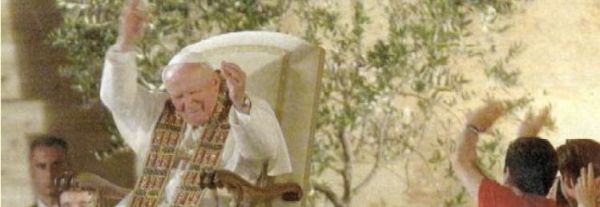1. “Why do you seek the living among the dead? He is not here, but has risen” (Lk 24:5).
These words of the two men dressed “in dazzling apparel” rekindle the hope of the women who had rushed to the tomb at the break of dawn. They had experienced the tragic events culminating in Christ’s crucifixion on Calvary; they had felt the sadness and the confusion. In the hour of trial, however, they had not abandoned their Lord.
They go secretly to the place where Jesus was buried in order to see him again and embrace him one last time. They are moved by love, that same love that led them to follow him through the byways of Galilee and Judea, all the way to Calvary.
What blessed women! They did not yet know that this was the dawn of the most important day of history. They could not have known that they, they themselves, would be the first witnesses of Jesus’ Resurrection.
2. “They found the stone rolled away from the tomb” (Lk 24:2).
So narrates the evangelist Luke, adding that, “when they went in they did not find the body of the Lord Jesus” (cf. 24:3). In one brief moment, everything changes. Jesus “is not here, but has risen”. This announcement, which changed the sadness of these pious women into joy, re-echoes with changeless eloquence throughout the Church in the celebration of this Easter Vigil.
A singular Vigil of a singular night. A Vigil, the mother of all vigils, during which the whole Church waits at the tomb of the Messiah, sacrificed on the Cross. The Church waits and prays, listening again to the Scriptures that retrace the whole of salvation history.
But on this night, it is not darkness that dominates but the blinding brightness of a sudden light that breaks through with the starling news of the Lord’s Resurrection. Our waiting and our prayer then become a song of joy: “Exultet iam angelica turba caelorum . . . Exult, O chorus of Angels!”
The perspective of history is completely turned around: death gives way to life, a life that dies no more. In the Preface we shall shortly sing that Christ “by dying destroyed our death, by rising restored our life”. This is the truth that we proclaim with our words, but above all with our lives. He whom the women thought was dead is alive. Their experience becomes our experience.
3. O Vigil imbued with hope, you fully express the meaning of the mystery! O Vigil rich in symbolism, you disclose the very heart of our Christian existence! On this night, everything is marvellously summed up in one name, the name of the Risen Christ.
O Christ, how can we fail to thank you for the ineffable gift which, on this night, you lavish upon us? The mystery of your Death and Resurrection descends into the baptismal waters that receive the old, carnal man and make him pure with divine youthfulness itself.
Into the mystery of your Death and Resurrection we shall shortly be immersed, renewing our baptismal promises; in a special way, the six catechumens will be immersed in this mystery as they receive Baptism, Confirmation and the Eucharist.
4. Dear Brother and Sister Catechumens, I greet you with all the warmth of my heart, and in the name of the Church gathered here I welcome you with brotherly affection. You come form different nations: Japan, Italy, China, Albania, the United States of America and Peru.
Your presence here in Saint Peter’s Square is indicative of the variety of cultures and peoples who have opened their hearts to the Gospel. On this night death gives way to life for you too, as for all the baptized. Sin is erased and a new life begins. Persevere to the end in fidelity and love. And do not be afraid when difficulties arise, for “Christ being raised from the dead will never die again; death no longer has dominion over him” (Rom 6:9).
5. Yes, dear Brothers and Sisters, Jesus lives and we live in him. For ever. This is the gift of this night, which has definitively revealed to the world the power of Christ, Son of the Virgin Mary, whom he gave to us as Mother at the foot of the Cross.
This Vigil makes us part of a day that knows no end. The day of Christ’s Passover, which for humanity is the beginning of a renewed springtime of hope.
“Haec dies quam fecit Dominus: exsultemus et laetamur in ea - This is the day that the Lord has made: let us rejoice in it and be glad”. Alleluia!
[Pope John Paul II, homily at the Easter Vigil 14 April 2001]












